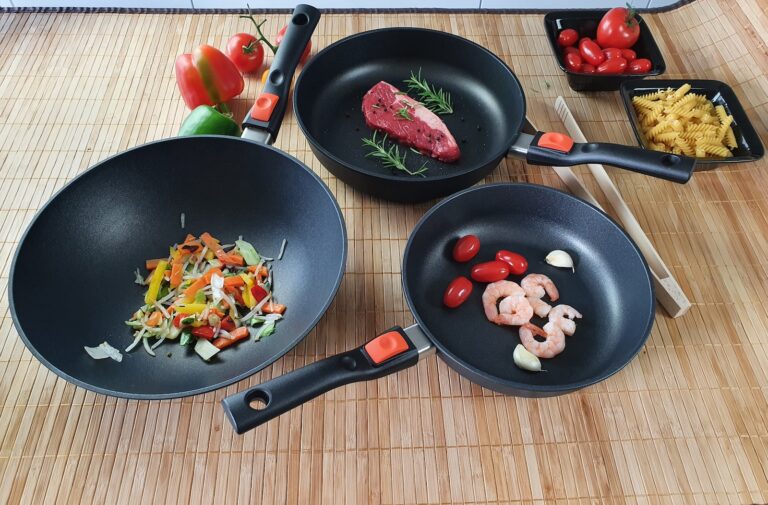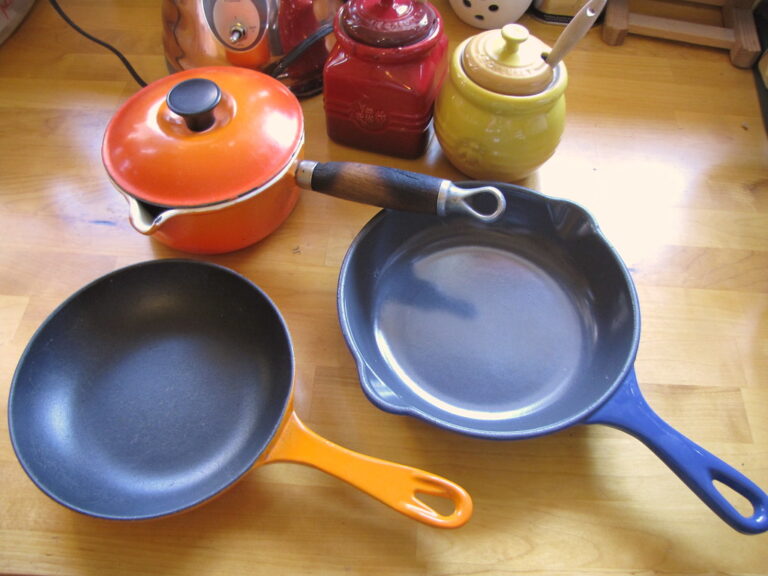As a passionate home cook and lover of all things culinary, I’ve always been intrigued by the artistry and precision of Japanese kitchen knives.
Today, I’m thrilled to share the secrets behind these remarkable tools. In this article, we’ll explore the history, craftsmanship, and unique materials used in their construction.
From revered Damascus steel to traditional forging techniques, we’ll uncover what makes these knives exceptional.
Join me on this fascinating journey as we unveil the secrets of Japanese kitchen knives and discover the artistry within each blade.
Key Takeaways
- Japanese kitchen knives have a rich heritage and craftsmanship, symbolizing tradition, skill, and precision.
- Different types of Japanese kitchen knives, such as Shun, Global, Miyabi, Masamoto, and Sakai Takayuki, offer unique features and designs.
- Using Japanese kitchen knives provides benefits such as effortless slicing, superior balance and control, precise cuts, durability, and longevity.
- The art of Japanese knife making involves exceptional craftsmanship, traditional forging methods, unique heat treatment processes, and regular maintenance using whetstones.
History and Evolution of Japanese Kitchen Knives
I find it fascinating to learn about the history and evolution of Japanese kitchen knives. One aspect that stands out to me is the evolution of knife handles.
In the early years, Japanese knives had simple wooden handles. However, as time went on, knife makers started experimenting with different materials, such as buffalo horn and various types of wood, to create handles that weren’t only functional but also aesthetically pleasing.
This evolution in knife handles reflects the meticulous craftsmanship and attention to detail that’s deeply ingrained in Japanese culture.
Furthermore, the cultural significance of Japanese knives can’t be overstated. They aren’t just tools for cooking, but symbols of tradition, skill, and precision.
The artistry and expertise that goes into making these knives is a testament to the rich heritage and craftsmanship of Japan.
Different Types of Japanese Kitchen Knives
As a culinary enthusiast, I’ve discovered a variety of distinct blades used in Japanese cuisine. Japanese kitchen knives are known for their precision and craftsmanship, and they offer several benefits that make them indispensable in the kitchen.
Here are some popular Japanese knife brands and the benefits of using Japanese kitchen knives:
- Shun: Known for their sharpness and durability, Shun knives are favored by both professional chefs and home cooks.
- Global: With their sleek design and lightweight construction, Global knives provide excellent balance and control.
- Miyabi: These knives are handcrafted in Japan and are praised for their exceptional sharpness and edge retention.
- Masamoto: A trusted brand among professional chefs, Masamoto knives are known for their superior cutting performance.
- Sakai Takayuki: Made in Sakai, Japan, these knives combine traditional craftsmanship with modern technology to create high-quality blades.
The benefits of using Japanese kitchen knives include their razor-sharp edges, which make slicing and dicing effortless, as well as their superior balance and control. The thin, lightweight blades allow for precise cuts, while the high-quality materials used in their construction ensure durability and longevity.
Overall, Japanese kitchen knives are a valuable tool for any culinary enthusiast or professional chef.
Unique Features and Design of Japanese Kitchen Knives
The unique features and design of these blades make them stand out in any kitchen. Japanese kitchen knives are known for their exceptional craftsmanship and cutting performance. They offer numerous benefits, such as superior sharpness, precision, and balance. Whether you’re a professional chef or a home cook, choosing the right Japanese kitchen knife for your needs is essential. Consider factors like the type of blade, the handle material, and your specific cutting style. To assist you in making an informed decision, here is a table outlining the benefits and considerations when selecting a Japanese kitchen knife:
| Benefits | Considerations |
|---|---|
| Exceptional sharpness | Requires regular sharpening |
| Precise cutting performance | Some blades are more fragile |
| Balanced and ergonomic design | Can be more expensive than other knives |
Remember to prioritize your preferences and needs when choosing a Japanese kitchen knife. With the right blade in hand, you can elevate your culinary experience and effortlessly prepare meals with precision.
The Art of Japanese Knife Making
Craftsmanship and attention to detail are key elements in the art of creating these exquisite blades. The importance of blade geometry in Japanese kitchen knives can’t be overstated. It plays a crucial role in the knife’s performance and functionality. The influence of traditional Japanese craftsmanship on knife making techniques is evident in the meticulous process of forging and shaping the blades.
Here are five fascinating aspects of Japanese knife making:
- Blade Geometry: Japanese knives are known for their precise angles and thin, sharp edges. The geometry of the blade allows for better cutting performance and precision.
- Traditional Forging Methods: Japanese knife makers often use traditional forging techniques, such as the ‘honyaki’ method, where a single piece of high-carbon steel is heated, hammered, and shaped into a blade.
- Hardening and Tempering: Japanese knives undergo a unique heat treatment process called ‘yaki-ire,’ where the blade is heated, quenched, and tempered to achieve optimal hardness and durability.
- Mastery of Craftsmanship: Knife making in Japan is considered an art form passed down through generations. Master craftsmen dedicate years to perfecting their skills and honing their techniques.
- Honing and Sharpening: Japanese knives require regular honing and sharpening to maintain their exceptional cutting performance. Traditional sharpening techniques, such as using whetstones, are still widely practiced.
The combination of blade geometry, traditional craftsmanship, and attention to detail make Japanese kitchen knives unparalleled in their quality and performance.
Tips for Caring and Maintaining Japanese Kitchen Knives
I find it important to properly care for and maintain my Japanese kitchen knives to ensure their longevity and optimal performance.
When it comes to choosing the right knife for your needs, it’s crucial to consider the type of steel used. Most Japanese knives are made of high-carbon steel or stainless steel. High-carbon steel offers excellent sharpness and edge retention, but it requires more maintenance to prevent rusting. On the other hand, stainless steel is more resistant to rust but may not hold its edge as long.
Common mistakes to avoid when caring for Japanese knives include using them on hard surfaces like glass or ceramic, soaking them in water for extended periods, and putting them in the dishwasher. Instead, hand wash and dry them immediately after use and store them in a knife block or sheath to protect the blade.
Frequently Asked Questions
How Do Japanese Kitchen Knives Compare to Western Kitchen Knives in Terms of Performance and Durability?
Japanese kitchen knives offer superior performance and durability compared to their Western counterparts. Their precise cutting abilities make them ideal for tasks requiring precision. The craftsmanship and quality of Japanese knives ensure longevity and reliability in the kitchen.
What Are Some Common Misconceptions About Japanese Kitchen Knives That People May Have?
Common misconceptions about Japanese kitchen knives include thinking they are all super sharp and delicate. Factors to consider when choosing one are the type of steel, blade design, and handle material.
Are There Any Special Techniques or Skills Required to Properly Use and Handle Japanese Kitchen Knives?
To properly use and handle Japanese kitchen knives, it’s essential to have a proper grip and learn sharpening techniques. These skills ensure precise cuts and maintain the knife’s sharpness, maximizing its efficiency and longevity.
What Are Some Key Factors to Consider When Choosing a Japanese Kitchen Knife That Is Suitable for Different Types of Cutting Tasks?
When choosing the right Japanese kitchen knife for different types of cutting tasks, there are several factors to consider. These include the type of steel, blade shape, weight, and handle design.
Are There Any Traditional Rituals or Customs Associated With Japanese Kitchen Knives That Are Worth Knowing About?
There are traditional rituals and customs associated with Japanese kitchen knives that are worth knowing about. Japanese knife sharpening techniques are highly respected, and the handle design of Japanese kitchen knives holds great significance.
Conclusion
In conclusion, Japanese kitchen knives are truly a work of art, with a rich history and exceptional craftsmanship. From their unique materials and designs to the traditional forging techniques, these knives are unparalleled in their sharpness and cutting performance.
By understanding the different types of Japanese knife styles and properly caring for these blades, you can enhance your culinary experience and take your cooking to new heights.
So, embrace the secrets of Japanese kitchen knives and unlock the true potential in your kitchen.




